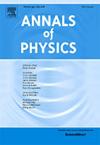Cosmological evolution in f(R,Lm,T) gravity with viscosity
IF 3
3区 物理与天体物理
Q2 PHYSICS, MULTIDISCIPLINARY
引用次数: 0
Abstract
We investigate the cosmological evolution of gravity, a theory that unifies and by considering a gravitational Lagrangian depending on the Ricci scalar , the matter Lagrangian , and the trace of the energy–momentum tensor. Focusing on the linear model and introducing a bulk viscous pressure , we constrain the model using cosmic chronometers, PantheonPlus+SH0ES, and BAO datasets. We analyze the evolution of , , , and , finding a transition from deceleration to acceleration around , and a shift from matter-like to dark energy-like behavior at low redshifts. The diagnostic reveals deviations from CDM, confirming a quintessence-like behavior. Our results highlight that viscosity and non-minimal couplings offer a viable mechanism for explaining the late-time acceleration of the universe.
f(R,Lm,T)重力与黏度的宇宙学演化
我们研究了f(R,Lm,T)引力的宇宙学演化,这是一个统一f(R,T)和f(R,Lm)的理论,通过考虑依赖于里奇标量R的引力拉格朗日量,物质拉格朗日量Lm和能量动量张量的迹T。以线性模型f(R,Lm,T)=R+αLm+βT为中心,引入体粘性压力pv=−3ζH,我们使用宇宙天文钟、PantheonPlus+SH0ES和BAO数据集对模型进行了约束。我们分析了H(z), q(z), ρ(z)和ω(z)的演化,发现在zt ~ 1附近从减速到加速的转变,以及在低红移时从类物质到类暗能量的转变。Om(z)诊断揭示了ΛCDM的偏差,确认了类似于精髓的行为。我们的研究结果强调,粘性和非极小耦合为解释宇宙的后期加速提供了一种可行的机制。
本文章由计算机程序翻译,如有差异,请以英文原文为准。
求助全文
约1分钟内获得全文
求助全文
来源期刊

Annals of Physics
物理-物理:综合
CiteScore
5.30
自引率
3.30%
发文量
211
审稿时长
47 days
期刊介绍:
Annals of Physics presents original work in all areas of basic theoretic physics research. Ideas are developed and fully explored, and thorough treatment is given to first principles and ultimate applications. Annals of Physics emphasizes clarity and intelligibility in the articles it publishes, thus making them as accessible as possible. Readers familiar with recent developments in the field are provided with sufficient detail and background to follow the arguments and understand their significance.
The Editors of the journal cover all fields of theoretical physics. Articles published in the journal are typically longer than 20 pages.
 求助内容:
求助内容: 应助结果提醒方式:
应助结果提醒方式:


